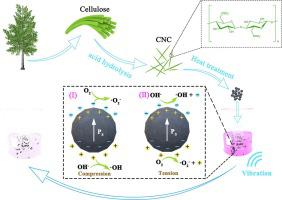Separation and Purification Technology ( IF 8.6 ) Pub Date : 2022-01-08 , DOI: 10.1016/j.seppur.2022.120450 Jingfei Guan 1, 2 , Yanmin Jia 1 , Tian Chang 3 , Lujie Ruan 1, 2 , Taosheng Xu 4 , Zhen Zhang 3 , Guoliang Yuan 5 , Zheng Wu 4 , Gangqiang Zhu 6

|
In this work, the cellulose nanocrystal (CNC) heat-treated in an air atmosphere at 300 °C shows the enhanced piezo-catalytic performance in Rhodamine B (RhB) dye decomposition. Under 180 min ultrasonic vibration with the power of 180 W and the frequency of 40 kHz, the piezo-catalytic decomposition ratio of the heat-treated CNC for RhB (5 mg/L) can reach ∼ 96.65%, far exceeding the 34.58% of the raw CNC. The improvement of the piezo-catalytic performance of the heat-treated CNC is attributed to the introduction of oxygen vacancy defects, which can cause the destruction of crystal structure symmetry and promote the carrier separation, resulting in the enhancement of piezoelectric effect of the heat-treated CNC. The free radical scavenger experiments confirm that the main active specie involved in piezo-catalysis is superoxide radical. Three recycling utilization results show that the decomposition ratio of RhB dye remains about 95% without significant loss, indicating that the heat-treated CNC possesses the good durability and high efficiency in piezo-catalysis. The introduction of oxygen vacancy defects into CNC to obtain the marvelous piezo-catalytic performance is expected to show broad application prospects in the catalytic treatment of dye wastewater.
中文翻译:

热处理纤维素纳米晶体的高效压电催化超声振动驱动染料分解
在这项工作中,纤维素纳米晶体 (CNC) 在空气气氛中在 300 °C 下热处理显示出增强的罗丹明 B (RhB) 染料分解的压电催化性能。在功率为 180 W、频率为 40 kHz 的 180 min 超声振动下,热处理后的 CNC 对 RhB (5 mg/L) 的压电催化分解率可达 ∼ 96.65%,远超前处理的 34.58%。原始CNC。热处理后的CNC压电催化性能的提高归因于氧空位缺陷的引入,会导致晶体结构对称性的破坏,促进载流子分离,从而导致热处理的压电效应增强。处理过的CNC。自由基清除剂实验证实,参与压电催化的主要活性物质是超氧自由基。三个回收利用结果表明,RhB染料的分解率保持在95%左右,没有明显的损失,表明热处理后的CNC具有良好的耐久性和压电催化效率。将氧空位缺陷引入CNC以获得奇妙的压电催化性能有望在染料废水的催化处理中显示出广阔的应用前景。


























 京公网安备 11010802027423号
京公网安备 11010802027423号